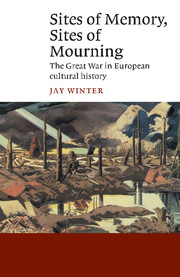Book contents
- Frontmatter
- Contents
- List of illustrations
- Acknowledgements
- List of abbreviations
- Introduction
- I Catastrophe and consolation
- 1 Homecomings: the return of the dead
- 2 Communities in mourning
- 3 Spiritualism and the ‘Lost Generation’
- 4 War memorials and the mourning process
- II Cultural codes and languages of mourning
- Notes
- Bibliography
- Index
2 - Communities in mourning
- Frontmatter
- Contents
- List of illustrations
- Acknowledgements
- List of abbreviations
- Introduction
- I Catastrophe and consolation
- 1 Homecomings: the return of the dead
- 2 Communities in mourning
- 3 Spiritualism and the ‘Lost Generation’
- 4 War memorials and the mourning process
- II Cultural codes and languages of mourning
- Notes
- Bibliography
- Index
Summary
Grief is a state of mind; bereavement a condition. Both are mediated by mourning, a set of acts and gestures through which survivors express grief and pass through stages of bereavement. Many of these moments are lived within families supported by social networks.
Families were torn apart by war. Nothing could have reversed completely this tide of separation and loss. But after 1914 there was as well a gathering together, as people related by blood or by experience tried to draw strength from each other during and after the war. The bonds thus formed were powerful and in many cases durable. The process of their formation and expression is at the heart of this chapter.
In all countries touched by the war, there was a progression of mutual help, a pathway along which many groups and individuals sought to provide knowledge, then consolation, then commemoration. These elements were always there, though the language in which they were expressed varied considerably.
First I approach the initial stages of bereavement in terms of discovery: of how relatives and friends heard the awful news about casualties, and what some of them were able to do about it. Some were near the front lines. Moreover, the sheer scale of the conflict made it difficult, if not impossible, to discover the whereabouts of individual soldiers, whether alive or dead, missing or at base camps, on leave or in transit.
- Type
- Chapter
- Information
- Sites of Memory, Sites of MourningThe Great War in European Cultural History, pp. 29 - 53Publisher: Cambridge University PressPrint publication year: 1998

